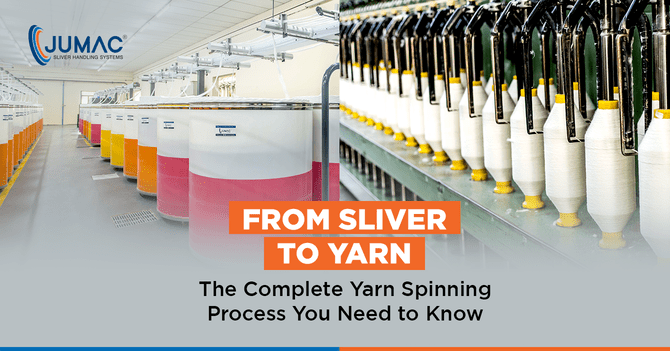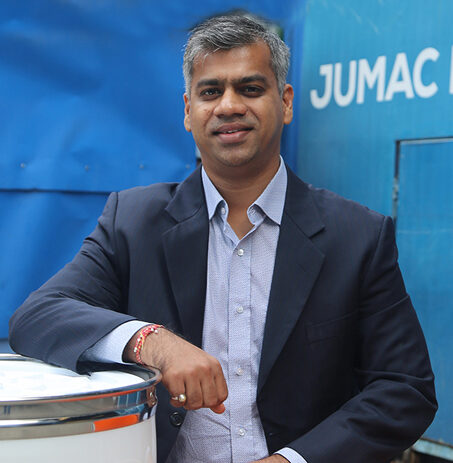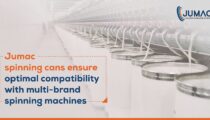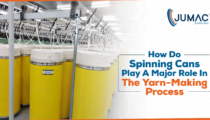The Indian textile industry has had a substantial place in…

From Sliver To Yarn – The Complete Yarn Spinning Process You Need to Know
Spinning is all about the process that is followed to transform fibres into yarns in their final form. Simple as it sounds, this process has multiple stages – and problems in any of these yarn spinning stages can lead to output quality being hampered and overall productivity being compromised. That’s precisely why all mill-operators (every stakeholder in the textile industry, for that matter) should have a clear idea about the different stages of spinning. Given that the reliability and usability of sliver can and related products also have a direct effect on operational efficiency levels, being aware about the best practices to use them is also vital. In what follows, we will take you through the broad phases in the fibre-to-yarn journey:
1. Bale Opening and Blending
The spinning process kickstarts with the bale opening. The cotton, which is present in bales in a heavily compressed form, is converted into a cleaner and looser form. Through careful blending, variations and inconsistencies in the yarn are minimised, and overall homogeneity is enhanced. The fibres are moved to the blending area, and the bales are opened at the same time. High-quality compressed air is used to make sure that the fibre-mixing is done in an uniform manner. Maintaining this homogeneity is important.
2. Unicleaning
Cotton, in its raw form, has plenty of accumulated dirt and contamination particles. These include seeds, sand grains, leaves & more – which have to be eliminated from the cotton bale. For this, the cotton fibre has to be compressed into streamlined sheets. At the end of this ‘unicleaning’ stage, the ‘lap’ is formed – which has to be further prepared and processed. Once all the ‘fibre-fragments’ and other such external elements are eliminated, the fibre becomes ready to be moved to the next stage.
3. Blowroom
This can be considered as the initial stage of the core spinning process. Opposing spikes, air current, and beaters are used in the blowroom – with the key objective being smooth and efficient removal of impurities from the cotton fibres. After the material is opened and the tufts are formed, thorough cleaning is done – and, if required, blending (if required, between two or more fibre types). The flocks (or laps) that are formed have proper width and height uniformity. In certain instances, the open fibres may also be transferred into a chute feed.
4. Carding
A systematic sequence of dividing / re-dividing activities is performed in the carding machinery, for carefully disentangling and intermixing the fibres. The ‘lay’ (which, in essence, is a thin fibre sheet) is formed during this stage. For this, the fibres are placed parallelly to each other. Impurities (which were not removed in the blowroom) and neps are removed at this stage. By opening individual tufts, and converting the lap into sliver, fibre becomes untwisted and smooth. Fibres are selected according to length, and those with the lowest length are discarded. Broadly speaking, this stage includes two broad action types – carding and stripping. It is also essential to use high-quality sliver can for carding, that would eliminate risks of yarn defects.
Suggested Read : Carding Method And Carding Machine Functions
5. Draw Framing
The sliver that comes out from the carding stage is, generally, rather uneven / non-uniform. As such, the sliver is not yet suitable for yarn production. The drawframing stage is vital in this context, since over here, the doubling and drafting machinery is used to create single strands from multiple strands that were obtained in the previous stage. Drafting, in particular, is done for fibre attenuation. Unevenness is minimised through equalising, parallelising is done to set yarn strength parameters, and variations in the raw material are made up for by blending. Removal of external dust particles also happens during the draw framing stage.
Note: For wool spinning, the GILLING process is done, for aligning the long fibres and getting rid of the relatively shorter ones.
6. Combing
A hugely important phase in yarn spinning, combing is where the actual formation of sliver takes place. Prior to that, all existing impurities present in the comber lap are eliminated, and short fibres are removed as well. The comber process includes several key actions, including lap feeding & nipping, roller detaching, piecing, and cylinder comb cleaning. A big percentage of fibre neps are done away with at the combing phase. The fibres are straightened too, and sliver evenness is maximised.
7. Roving or Speed Frame
In this stage, a standard roving frame is present, for feeding the drawn slivers, and adding a proper twist to them. Spinning can products are used to collect these ‘roving strands’ – following which, they are transferred to the spinning machinery. The roller speed is gradually increased (through which the sliver is passed). The linear fibre density is minimised, and the overall sliver size is brought down to make it ideal for yarn spinning. The speed frame here performs three main functions: a) drafting (to reduce per unit sliver length), b) twisting (to add roving strength), and c) winding (for winding on the roving bobbin).
8. Ring Frame
The fineness of the fibre gets a significant boost with the help of ring frame. The roving is drafted for enhancing this fineness, and yarns of the requisite count & strength levels are formed (by twisting). To ensure secure, damage-free storage and processing of the twisted yarn, the latter is winded in the bobbin. The processes that take place in the ring frame include drafting, creeling, doffing, twisting, winding and building.
9. Spinning and Winding
Finally, yarn strengthening is done in the spinning stage, by adding a certain level of ‘twit’. Following this, ring bobbin winding is done. The package size should ideally be relatively large – to ensure better productivity and efficiency. Auto coners are used for precisely this purpose. Splicing and/or cutting is done too, for doing away with possible yarn imperfections (poor thickness, slubs, etc.). Advanced auto coners generally have automated splicing / cutting tools.
Note: In addition to the above, there are other, more new-age spinning methods – like air jet spinning, open-end spinning, and friction spinning.
Choice of spinning can in particular, and material handling systems in general, is of immense importance in yarn spinning processes at mill floors. For instance, if the cans chosen by a mill are not compatible with the installed spinning machinery (e,g., Rieter or Trutzschler or any other OEM), that can lead to significant production downtimes and problems. Each of the spinning stages has to be carried out with a lot of care and precision, to ensure that the final yarn quality is at par with the finest.

Passionate about transforming the industrial sector of textile and spinning industry with innovative solutions. Director at Jumac Manufacturing, leading spinning cans and accessories manufacturer and exporter from Kolkata, India.









